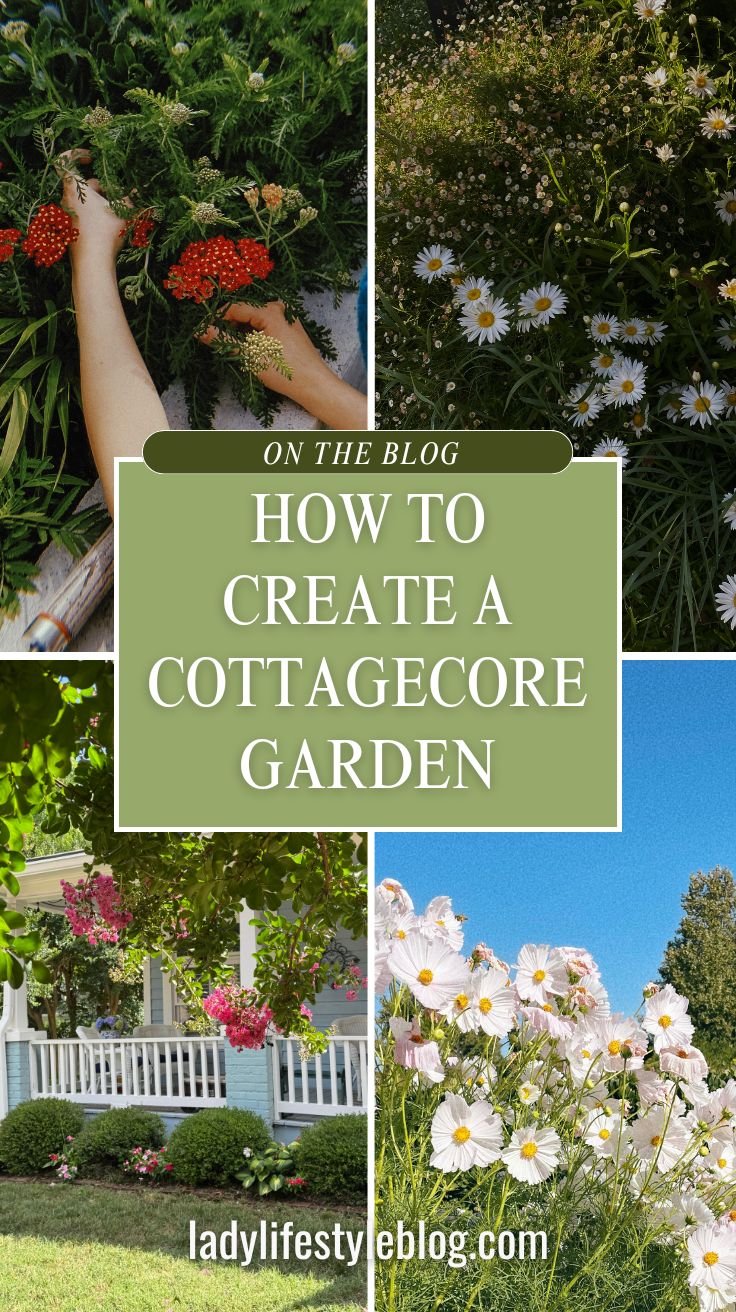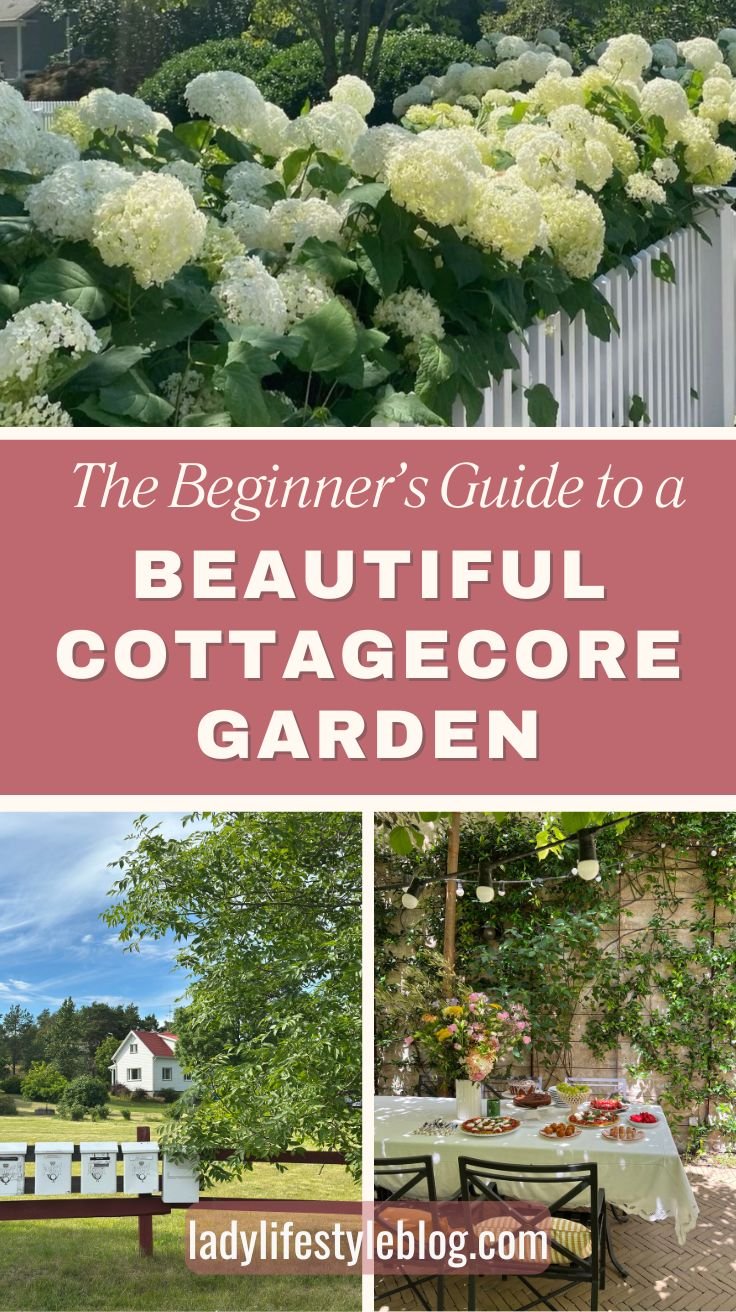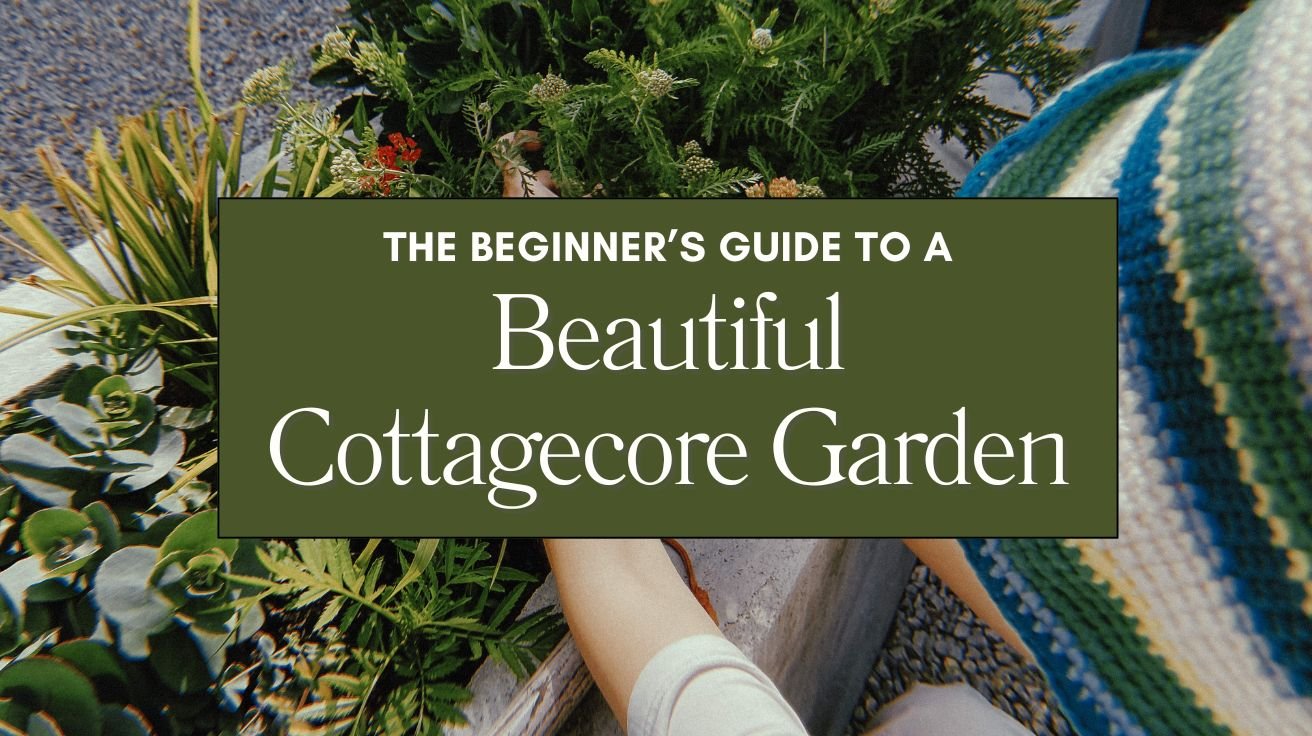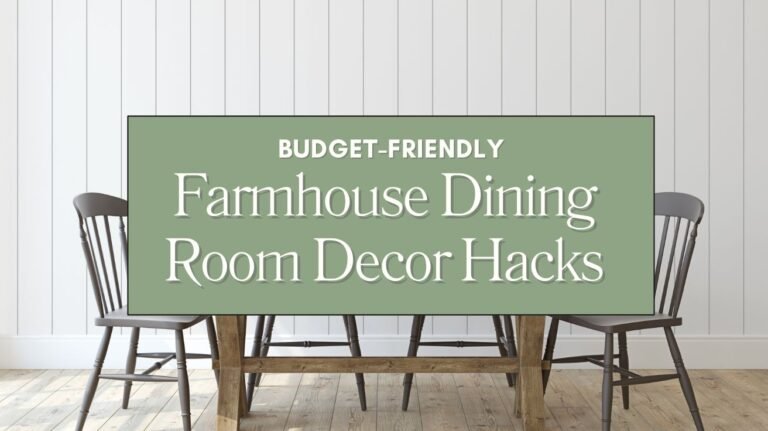I was never someone who dreamed of grand, manicured landscapes. For me, the charm of a cottagecore garden lives in its imperfections—the wildflowers spilling over old pots, the moss softening the edges of a crooked path, and the way ivy quietly takes over a forgotten fence. I’ve realized that creating a cottagecore garden isn’t about chasing perfection. It’s about building a space that feels gentle, a little wild, and completely your own.
I started noticing how this style of garden invites you to slow down. It doesn’t need to impress anyone—it just needs to offer you moments of quiet beauty. If you’ve been dreaming of your own storybook garden, this step-by-step guide will help you begin. I hope it inspires you to embrace the messy magic and let something beautiful grow.
What You’ll Need to Begin
When I began creating my own cottagecore garden, I quickly learned that it wasn’t about buying a bunch of expensive tools or rare plants. It’s about layering simple, thoughtful touches over time.
Essentials for Your Cottagecore Garden:
- A packet (or three) of wildflower seeds
- Hand tools: trowel, pruners, gloves
- A watering can (the older it looks, the better)
- Rustic containers: crates, metal tins, terracotta pots
- A garden bench, old chair, or wicker seat
- A trellis, archway, or even a clothesline for climbing plants
- Stones, bricks, or wood for edging paths
- Solar fairy lights or lanterns
- Patience, time, and a little imagination

Step 1: Start With a Wildflower Corner
Why it Works:
I’ve been amazed by how quickly wildflowers can transform even the barest patch of soil into something magical. These flowers thrive on neglect and reward you with blooms that invite bees, butterflies, and all those small wonders that make a garden feel alive.
How to Do It:
- Choose a sunny patch—this could be a corner of your yard or even several pots on a balcony.
- Loosen the soil with a hand rake or spade.
- Scatter a wildflower seed mix generously. I like to use blends that include cosmos, poppies, chamomile, and cornflowers for that messy, old-fashioned look.
- Press the seeds lightly into the soil with your hands or a rake.
- Water gently and wait. Some flowers will sprout fast; others may surprise you later.
Personal Note:
I was amazed at how forgiving this step is. I forgot to water for a few days, and still, by midsummer, my corner was alive with bees and soft pink cosmos stretching taller than I expected.
Picture This:
A breeze catches the petals, bees hover lazily, and your messy little patch looks like it’s been there forever.
Step 2: Add a Meandering Path
Why it Works:
For me, a path makes even the smallest garden feel like it has somewhere to lead. It creates a sense of story and invitation, even if it only winds its way to a single chair.
How to Do It:
- Mark out a soft, curving path with sticks or a garden hose to visualize the shape.
- Line it with bricks, stones, or even reclaimed wood. Uneven edges make it feel more natural.
- Leave gaps between the stones for moss or creeping thyme to grow.
- Let nature blur the edges over time—this isn’t about straight lines.
Personal Note:
I’ve realized I don’t love paths that look too planned. I let mine curve unexpectedly, and now it feels like it’s always been there, gently leading me toward quiet moments.
Picture This:
An uneven line of mossy stones leading to a bench half-hidden behind wildflowers.
Step 3: Incorporate Vintage Garden Decor
Why it Works:
I love how vintage touches make a garden feel layered with stories. An old watering can, chipped pots, and forgotten tools all bring character.
How to Do It:
- Collect items from flea markets, antique shops, or your attic. Think: enamel jugs, birdcages, wire baskets.
- Repurpose them as planters, garden storage, or simply place them where they catch the eye.
- Mix these with natural elements—wood, rust, and clay fit beautifully into a cottagecore scheme.
Personal Note:
I started noticing how these old things soften a garden’s edges. My enamel teapot now overflows with trailing ivy, and it makes me smile every time I pass.
Picture This:
A cracked teapot planted with moss, sitting on a faded wooden crate beneath an arch of climbing roses.
Step 4: Create a Cozy Seating Nook
Why it Works:
Every garden needs a spot where you can sit, sip tea, and simply watch things grow. I’ve been learning how much joy comes from having a place that feels made just for you.
How to Do It:
- Choose a quiet, somewhat hidden corner for your seat.
- Place a simple bench, wicker chair, or even a reclaimed wooden crate.
- Surround it with potted plants, climbing vines, or hanging lanterns.
- Layer it with soft cushions, a throw blanket, or even an old quilt for extra comfort.
Personal Note:
I was surprised how quickly this nook became my favorite place to be. It’s where I read, write, or just listen to the wind moving through the leaves.
Picture This:
A faded bench, draped with a soft blanket, tucked between foxgloves and lavender.
Step 5: Let Something Climb and Bloom
Why it Works:
I started noticing how vertical spaces bring a garden to life. Climbing plants add height, softness, and that slightly overgrown fairytale feeling.
How to Do It:
- Install a wooden archway, simple trellis, or even stretch wire between posts.
- Plant climbers like sweet peas, clematis, or rambling roses at the base.
- Guide the first shoots with soft ties, then let nature take over.
Personal Note:
I’ve been watching my roses stretch higher each year, weaving themselves into new shapes I never planned. It feels a bit like letting the garden tell its own story.
Picture This:
A wooden arch tangled with pale pink roses, petals softening the path below.
Step 6: Weave in Herbs and Edible Blooms
Why it Works:
I love how herbs bring both beauty and usefulness. Their scents, textures, and quiet growth add richness to the garden, and they make your kitchen rituals feel connected to the outdoors.
How to Do It:
- Plant lavender, mint, rosemary, and chamomile in pots or between flowers.
- Mix herbs with edible blooms like nasturtiums, calendula, and borage.
- Use mismatched containers—terracotta, tin, and wicker all work beautifully.
Personal Note:
I’ve been gathering handfuls of mint and chamomile to steep in tea, and it feels like such a small but lovely ritual.
Picture This:
Herbs tumbling from cracked pots, filling the air with scent as bees linger between blooms.
Step 7: Add Soft, Glowing Light
Why it Works:
I’ve realized there’s nothing quite as magical as a garden at dusk, lit softly with fairy lights and lanterns. It makes even the smallest space feel enchanted.
How to Do It:
- String fairy lights along trellises, fences, or tree branches.
- Tuck solar lanterns or jars with LED lights along paths.
- Focus on warm, soft lighting rather than anything too bright.
Personal Note:
I was surprised how much this changed the space—it feels alive even at night, glowing gently like something out of a storybook.
Picture This:
Soft lights twinkling through ivy as night settles in, the air filled with the scent of warm earth and flowers.
Step 8: Welcome a Little Wildness
Why it Works:
I’ve realized that a true cottagecore garden isn’t about control. It’s about trust—letting nature creep in and soften the edges.
How to Do It:
- Skip harsh chemicals and embrace organic gardening.
- Allow wild plants, moss, and clover to fill in gaps.
- Plant native species and leave space for wildlife—birds, bees, and butterflies included.
Personal Note:
I’ve been watching my little corner fill with unexpected surprises: a poppy where I didn’t plant one, moss softening stones, and birds nesting nearby.
Picture This:
A tangle of green, a soft hum of bees, and dappled sunlight turning everything gold.
Step 9: Add Personal Touches That Matter to You
Why it Works:
A garden should tell your story. I love tucking in small, sentimental touches—things that might not mean anything to anyone else but make the space unmistakably mine.
How to Do It:
- Hang a windchime, carve your initials into a stepping stone, or paint a garden sign.
- Leave little surprises: a painted rock, a secret path, a tucked-away quote.
- Let your personality shape the space slowly over time.
Personal Note:
I’ve started writing tiny notes to myself and hiding them among the flowers. It feels like planting little reminders of hope.
Picture This:
A stone etched with words only you understand, nestled under a climbing rose.
What I’m Still Dreaming of Adding One Day
Even though my little garden is slowly coming together, I’ve realized there’s always something new to wish for. That’s part of the fun, isn’t it? A cottagecore garden isn’t really a checklist—it’s a story unfolding in seasons. These are a few of the dreamy additions still on my list, saved for “someday” when the time (or budget) feels right.
A Weathered Greenhouse
I’ve been swooning over old glass greenhouses with climbing roses creeping up the sides and herbs lining the inside shelves. Somewhere between practical and romantic, it feels like the ultimate secret garden touch.
A Bird Bath (That Looks a Bit Forgotten)
There’s something so sweet about a mossy bird bath half-tucked between flowers. I imagine it catching rainwater, attracting little visitors, and looking like it’s been there for decades.
An Archway Covered in Rambling Roses
Every time I see photos of rose-covered archways, I tuck the idea away for later. One day, I’d love a soft, petal-strewn entrance to my garden, with just enough overgrowth to make it feel hidden and a little magical.
A Reading Nook Beneath an Overgrown Canopy
Somewhere quiet, with a chair that looks like it’s been forgotten on purpose. A place to sip tea, read old books, and listen to the wind through the leaves.
A Little More Wildness
I’m learning to let go of control, but I still catch myself tidying too much. Someday, I hope my garden feels fully softened at the edges—wilder, freer, like nature finished what I started.
Pro Tip:
Your garden doesn’t have to be “done.” In fact, the best ones never are. Let it evolve slowly, and give yourself permission to keep dreaming.
Final Thoughts: What I Hope You’ll Take Away
I’ve been learning that a cottagecore garden doesn’t bloom overnight. It grows slowly, alongside you—through seasons, small moments, and quiet afternoons spent noticing things you might have missed before.
I hope this guide helps you see that it’s less about perfection and more about presence. A place where you can sip tea, watch flowers open, and feel just a little more connected to the softer side of life.

At Lady Lifestyle Blog, I use AI as a tool to assist with research, idea generation, and content refinement. While much of my content is shaped with AI’s help, I personally review and adjust each post to ensure it aligns with the blog’s style and purpose. My focus is on providing stylish, creative, and practical inspiration for every modern lady!



